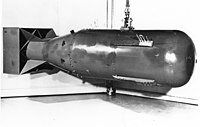
Photo from wikipedia
Abstract This paper numerically investigates the flame propagation of dust layer explosion induced by weak ignition, for which a two-dimensional model of deposited coal dust ignited at one end in… Click to show full abstract
Abstract This paper numerically investigates the flame propagation of dust layer explosion induced by weak ignition, for which a two-dimensional model of deposited coal dust ignited at one end in a closed pipe is simulated. By a change of the thickness and particle size of the deposited dust layer, the development processes of deposited dust after one end spark ignition can be divided into four situations: non-ignition, halfway quenching, slow combustion and explosion. The optimum thickness of deposited dust layer for violent explosion is 3 mm by changing the particle size. Varying the dust layer thickness, the optimum particle size for violent explosion is 50 µm. When the particle size of dust is 50 µm and the dust layer thickness is 3 mm, the maximum explosion overpressure is 0.55 MPa and the maximum flame propagation velocity is 6.5 m/s. The flame quenches during propagating to downstream when the raised dust concentration is above 0.8 kg/m3. Weak ignition at one end cannot induce explosion when dust layer thickness is less than 0.5 mm.
Journal Title: Fuel
Year Published: 2020
Link to full text (if available)
Share on Social Media: Sign Up to like & get
recommendations!